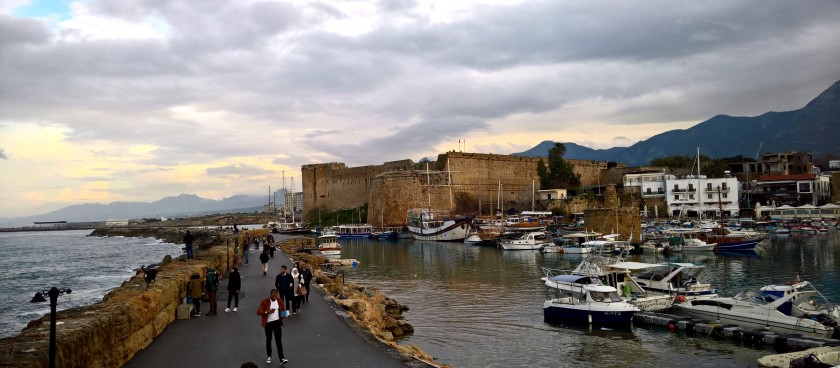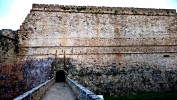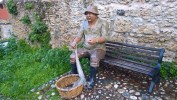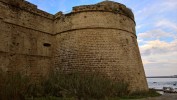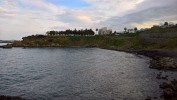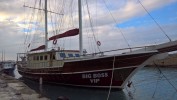- #CY71
- Küpdemir Sk, Girne 99300
- Working hours*:
June - September 8:00 -18:00;
October-May 8:00-16:00. - Prices*:
YTL14 - adult;
YTL5 - student. - * - opening and closing times as well as entrance prices, are subject to alterations without notice. Visitors are advised to check before visiting.
- 35.3419000, 33.3225310 Copy to clipboard Copy
-
#Castles , #Family time
The castle which lies to the north - east of Kyrenia dominates the harbour and is built on the tetragonal form.
It is first referred to by ancient sources in the year 1191 A.D. When the English King Richard The Lion Heart defeated lsaac Comnenus on his way to the Crusades and conquered Cyprus.
Explorations carried out in and around the castle take us as far as the Hellenistic and Roman Period (111 - 11 B.C.) But so far it has not been possible to establish the exact day of construction of the castle. As a result of the examinations carried out at the site, it is thought likely that, the original castle was built in the VII. A.D. by the Byzantines for the purpose of defending Kyrenia against Arab raids. The castle which had additions made to it during the reign of the Lusignans and was given its present from by the Venetians has come down to us a well preserved state.
The construction of the Kyrenia Castle which according to ancient historians and travellers was very important for the defence of the island, can be examined in three stages based on historical sources and existing remains.
The Castle of the Early Byzantine Period (VII - XII A.D.)
The Castle of the Lusignan Period (1208 - 1211 A.D.)
The Castle of the Venetian Period (1489 - 1570 A.D.)
It is known that a large portion of the present castle was built by King John d'Ibelin between 1208 - 1211 A.D. and that existing fortifications of the Early Roman Period were also made us of.
Kyrenia Castle The castle was used by the Lusignan kings as a resting place in time of peace and as a place of shelter in time of war. it is possible that the first alteration to the castle was done during this period. The castle received great damage as a result of Venetian attacks in 1373 A.D. It was captured by the Venetians in 1491 A. D. and was altered by them in accordance with their own defence plans towards the beginning of the XVI. A.D.
The castle was surrendered to the Ottomans in 1570 A.D. without resistance and remained in Ottoman hands for about three centuries. During the British Colonial administration it was used as a prison and police school. Although it was open to visitors during 1963 - 1967, a large portion of it was used by seamen belonging to the Greek National Guard as military headquarters. At present it is under the control of the Directorate of the Department of Antiquities and Museums.
Description of the Castle
Kyrenia Castle - The Lusignan TowerThe entry to the castle is through its north-west entrance which is opposite to a bridge covering the moat. The moat which covers the landsight of the castle was full of water prior to XIV. A.D. and served the purpose of an interior harbour to the castle in those days. From this first gate, lying to the north west of the fortified wall built by the Venetians in XIV. - XV. A.D. you go to the entrance of the Lusignan castle following a vaulted corridor.
Two Lusignan coat-of-arms over this wall were previously outside the castle and were manted in their position during the beginning of the present century. Through a closed passage to the left of the corridor you enter a church in the form of a cross dating to Early Byzantine Period (The Church of St. George). The dome of this temple which has marble columns with Corinthian capitals was restored very recently. The Corinthian capitals of the marble columns were taken from an older building elsewhere and placed here.
Inside the Kyrenia CastleThis Church which was outside the castle walls during the time of the Byzantines and the Lusignans, was left within the castle after the fortified walls were built by the Venetians.
The West wall, the north - west tower, the south wall and south - eastern and west towers of the castle which is stoutly built and has gunfurrets, belong to the Venetian Period.
The tomb in the entrance corridor of the Lusignan castle belongs to the Algerian Turkish Admiral Sadik Pasha who took over Kyrenia in 1570 A.D. Through this entrance corridor you arrive in an open yard. The big constructions containing arched rooms (royal guard rooms, prison etc.) to the north and east of the yard belong to the Lusignan Period. The Royal quarters to the west of the yard, as well as the big and arched windows of the little Latin Temple, at present without a roof above this part, display the characteristics of Lusignan Period. On the southern part of the yard there are fortifications and remains belonging to the Byzantine Period.
Here, the Lion reliefs over a wall must have been taken from a Roman construction. In this part after you pass the fortification wall at the west end (belonging to the Byzantine Period) you come to the rooms belonging to the Lusignan Period. To the North western tower to the horse-shoe shaped castle - which is an original Lusignan construction - you go by steep stairs. Below this tower, which was used in subsequent periods in the same form and remained sound to the present day, there are original Lusignan construction where sharp arches are joined together. The fact that there are arrow battlements in this construction which is in the form of two wide rooms one on top of the other has a special significance. In the guardrooms of the Lusignan Period, lying at the east of the castle, there is the shipwreck museum opened in the year 1976.
